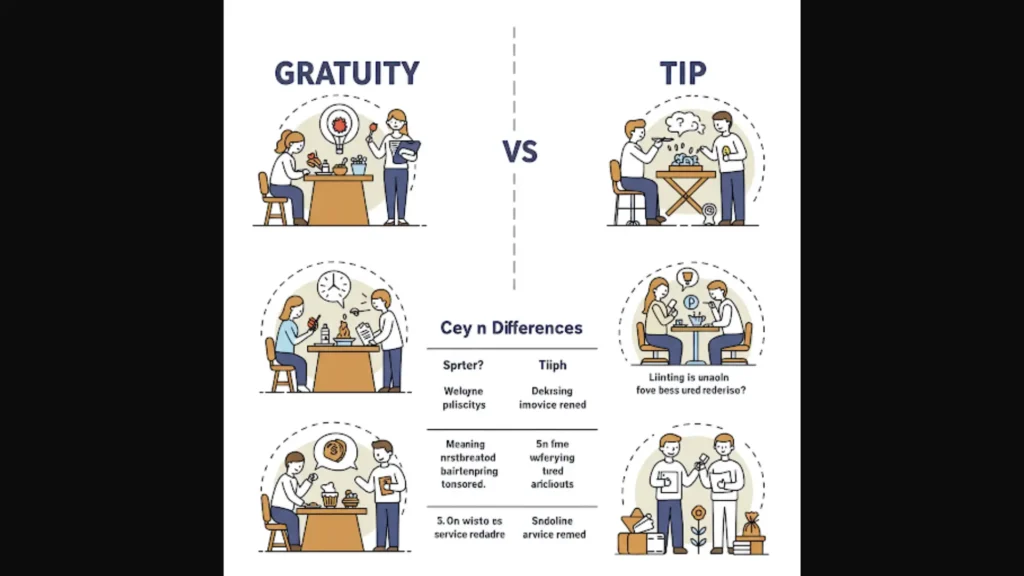Gratuity vs Tip – Understanding the Difference
Gratuity vs tip are two terms often used interchangeably, but they have distinct meanings when it comes to rewarding service workers optional or compulsory. Whether you’re dining at a restaurant, staying at a hotel, or using a professional catering or wedding service, understanding the difference between a gratuity and a tip can help you navigate payment etiquette effectively. Check you Gratuity payment and Annual reward From UAE Gratuity Calculator.

What Are Tips and Gratuities?
A gratuity, while often used interchangeably with a tip, can sometimes be automatically added to a bill, particularly for large parties in restaurants or specific service industries. It is typically a set percentage of the bill.
A tip is a voluntary sum of money given by a customer to a service provider as a token of appreciation for good service. It is usually given in addition to the total bill and is not mandatory.
The Technical Difference Between a Tip and a Gratuity
The key difference lies in their voluntary nature. Tips are given at the discretion of the customer, whereas gratuities can be pre-determined by the establishment administrative and included in the bill.
Service Charges, Gratuity, and Tips – What You Need to Know
What Is a Service Charge?
A service charge is a mandatory fee added to a bill for services provided. Unlike a tip or gratuity, it is not optional and is typically distributed among staff members by the employer.
How Service Charges Differ from Tips and Gratuities
Service charges are fixed and obligatory, whereas tips and gratuities are discretionary payments that may vary based on service quality and customer satisfaction.
Is a Mandatory Service Charge Equivalent to a Tip?
No, a mandatory service charge is not legally considered a tip. Many jurisdictions require businesses to disclose how service charges are distributed.

Auto Gratuity and Its Legal Aspects
What Is an Automatic Gratuity?
An automatic gratuity is a pre-set amount added to the bill, commonly seen in restaurants for large groups or in hospitality services.
Auto Gratuity Laws and Regulations
Laws regarding automatic gratuity vary by location. Some regions require businesses to treat auto gratuity as a service charge rather than a tip, affecting taxation and employee wages.
Understanding Gratuity Fees in Restaurants
Gratuity fees help ensure fair compensation for service staff but can sometimes be controversial if not clearly communicated to customers.
How Businesses Handle Tips and Gratuities
Reporting and Distribution of Tips
Businesses may require employees to report their tips for tax purposes, and some establishments pool tips for equal distribution among staff.
How Employers and Employees Handle Tips
Employers may implement tip-sharing policies, while employees must comply with legal reporting requirements.
The “Tip Credit” Rule for Employers
In some regions, employers can use a portion of employees’ tips to meet minimum wage obligations, known as the “tip credit” rule.
Gratuity vs Tip: Global Perspectives
Tipping Culture Around the World
Tipping practices vary significantly by country. In the U.S., tipping is customary, while in Japan, it is often considered unnecessary or even rude.
The Role of Gratuities in Different Countries
Different nations regulate gratuities differently, with some incorporating service fees into wages and others relying heavily on tipping.
Best Practices for Consumers
When and How to Tip?
Consumers should tip based on service quality, local customs, and industry standards. Common tipping rates range from 10% to 20%.
Cash vs Non-Cash Tips
While cash tips provide direct benefits to service workers, digital payments or credit card tips may be subject to processing fees or employer deductions.
Why You Should (or Shouldn’t) Give a Tip?
Tipping rewards good service and supports workers in tip-dependent industries. However, some argue that tipping culture shifts the responsibility of fair wages from employers to customers.
The Future of Gratuity vs Tip
The Evolution of Tipping Culture
With digital transactions and service charge inclusions, tipping is evolving. Some businesses are moving toward no-tipping models.
Balancing Tradition and Fairness in Gratuity Practices
There is ongoing debate on whether gratuities should be replaced with fair wages, ensuring employees receive stable income without relying on tips.
FAQs on Gratuity vs Tip
Conclusion
Understanding the differences between Gratuity vs Tip, and service charges helps both consumers and businesses navigate fair compensation practices. As tipping culture evolves, awareness of legal and ethical aspects is crucial for all parties involved.








